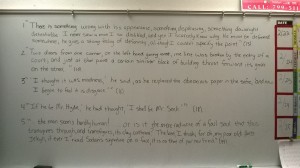This Strange Case of Dr. Jekyll and Mr. Hyde literary analysis assignment will work for any piece of literature. I just happened to use it most recently with Jekyll and Hyde, so that’s where all my examples come from.
It involves throwing papers in trash cans.

The majority of assignments will look like this the first time.
Common Core Standards
- RL.9-10.1 Cite strong and thorough textual evidence to support analysis of what the text says explicitly as well as inferences drawn from the text.
- RL.9-10.2 Determine a theme or central idea of a text and analyze in detail its development over the course of the text, including how it emerges and is shaped and refined by specific details; provide an objective summary of the text.
A little preparation will make the lesson go more smoothly.
1. Write a few quotations on the board from the novel or short story your currently reading. I chose five examples for this post, not because five is a magic number, but because I ran out of room on the white board.

Quotes from Dr. Jekyll and Mr. Hyde on my actual board in my actual classroom. Hope you enjoyed this inside look into my exciting world!
2. Be ready to give an example. Your students are going to need it. I projected the assignment explanation for all to see. Again, my examples are from a Jekyll and Hyde literary analysis assignment. Yours can be from whatever you’re currently reading. Here’s the document with examples that I showed my eager young scholars: Instructions and Example for Literary Analysis Assignment
Here’s a list of novels, plays, and other literary works you can find quotes on at RealStudyGuides.Net
Once the preparation is done, the lesson is easy.
Day 1
-
Let’s transform the complex to the simple.
Tell students the assignment.
- Show students how to do the assignment with the aforementioned Instructions and Example for Literary Analysis Assignment. It may be more effective to model how to do it right before your students’ very eyes. It will be like a mad science experiment happening in your classroom.
- Instruct students to choose two quotations to write about (or let them find their own).
- Instruct students to circle the better of the two. That’s the one you’re going to read.
Day 2
- Read each student’s assignment (anonymously) to the class.
- If it satisfactorily meets the requirements of a literary analysis, it goes in the ‘A’ pile. You’ll probably want to discuss why it’s good and allow student input into the decision (they’ll be more brutal evaluating it than you).
- If it does not satisfactorily meet the requirements of a literary analysis, it goes in the trashcan. You’ll definitely want them to redo it.
Some students will get it right on the first try. Most will get it right the second try. Some, it takes multiple tries. The key is that everybody does it right and actually learns the skill. In addition, everyone will eventually get an ‘A’.
Speak Your Mind